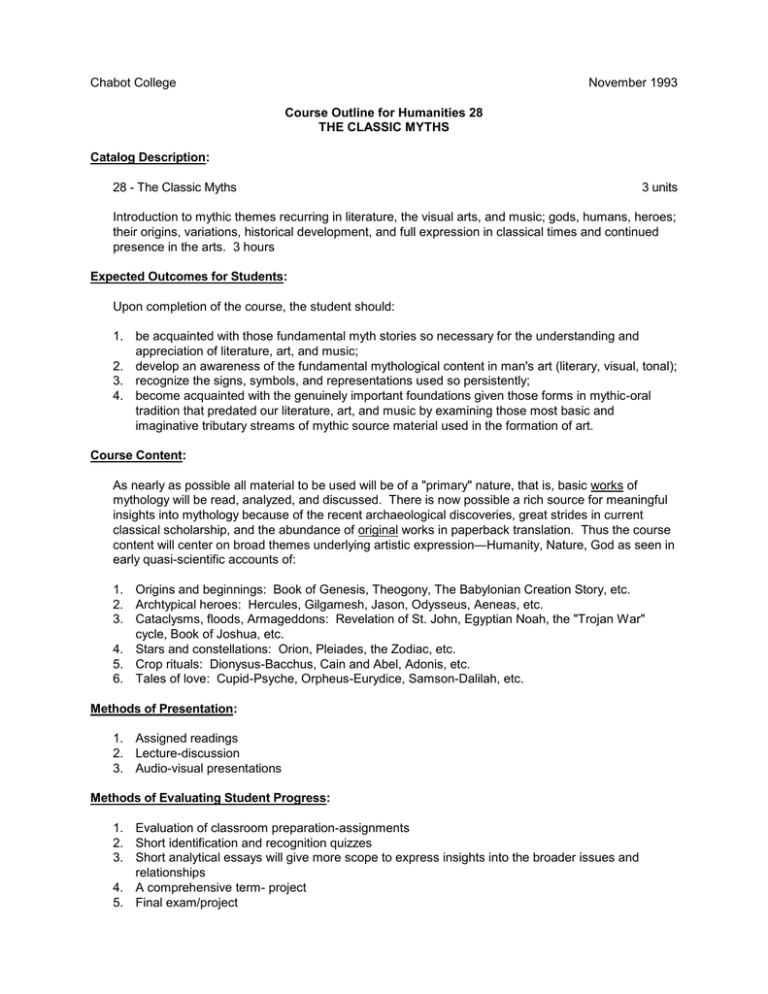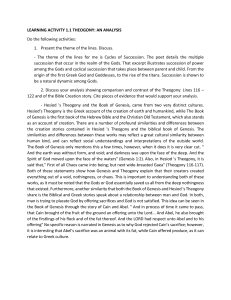Chabot College November 1993 28 - The Classic Myths
advertisement

Chabot College November 1993 Course Outline for Humanities 28 THE CLASSIC MYTHS Catalog Description: 28 - The Classic Myths 3 units Introduction to mythic themes recurring in literature, the visual arts, and music; gods, humans, heroes; their origins, variations, historical development, and full expression in classical times and continued presence in the arts. 3 hours Expected Outcomes for Students: Upon completion of the course, the student should: 1. be acquainted with those fundamental myth stories so necessary for the understanding and appreciation of literature, art, and music; 2. develop an awareness of the fundamental mythological content in man's art (literary, visual, tonal); 3. recognize the signs, symbols, and representations used so persistently; 4. become acquainted with the genuinely important foundations given those forms in mythic-oral tradition that predated our literature, art, and music by examining those most basic and imaginative tributary streams of mythic source material used in the formation of art. Course Content: As nearly as possible all material to be used will be of a "primary" nature, that is, basic works of mythology will be read, analyzed, and discussed. There is now possible a rich source for meaningful insights into mythology because of the recent archaeological discoveries, great strides in current classical scholarship, and the abundance of original works in paperback translation. Thus the course content will center on broad themes underlying artistic expression—Humanity, Nature, God as seen in early quasi-scientific accounts of: 1. Origins and beginnings: Book of Genesis, Theogony, The Babylonian Creation Story, etc. 2. Archtypical heroes: Hercules, Gilgamesh, Jason, Odysseus, Aeneas, etc. 3. Cataclysms, floods, Armageddons: Revelation of St. John, Egyptian Noah, the "Trojan War" cycle, Book of Joshua, etc. 4. Stars and constellations: Orion, Pleiades, the Zodiac, etc. 5. Crop rituals: Dionysus-Bacchus, Cain and Abel, Adonis, etc. 6. Tales of love: Cupid-Psyche, Orpheus-Eurydice, Samson-Dalilah, etc. Methods of Presentation: 1. Assigned readings 2. Lecture-discussion 3. Audio-visual presentations Methods of Evaluating Student Progress: 1. Evaluation of classroom preparation-assignments 2. Short identification and recognition quizzes 3. Short analytical essays will give more scope to express insights into the broader issues and relationships 4. A comprehensive term- project 5. Final exam/project Chabot College Course Outline for Humanities 28, Page 2 November 1993 Textbook(s) Typical: The Greek Myths, Graves, Pelican The Iliad, Homer, Chicago Theogony, Hesiod, Bobbs-Merrill The Voyage of Argo, Apollonius of Rhodes, Penguin Tiger at the Gates, Giraudoux, Samuel French The Parthenon, Ictinus, Athens Special Student Materials: None KH:kh Hum 28 Revised: 11/8/93


